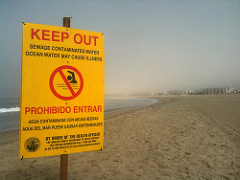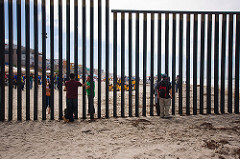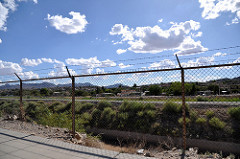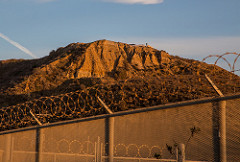
Community workshops conducted to follow National Environmental Policy Act regulations help the public gain trust in government projects; "Workshop in Santander" (CC BY-NC 2.0) by FIWARE
NEPA waivers release a project from the law's environmental planning requirements. The three types of NEPA exemptions are:
Source — Kate R. Bowers, Harvard Law Paper
NEPA exemptions are given to speed up a project and avoid lawsuits. Visit our "What is NEPA?" page to learn more about why the public commonly sues under NEPA to stop federal government projects.
We will periodically update the NEPA waiver list.

The Trans-Alaska Pipeline began shortly after the National Environmental Policy Act (NEPA) was passed. This made the project somewhat of a guinea pig for the new environmental planning law. Opposition groups alleged the pipeline's Environmental Impact Statement (EIS) did not adequately address project alternatives and sued to stop construction.
The court declined to rule on the EIS but did halt construction because of a Mineral Leasing Act violation. In response, Congress passed the Trans-Alaska Pipeline Authorization Act, which repealed the Mineral Leasing Act restrictions and eliminated judicial review of the EIS.
Sources
Congress provided a NEPA waiver for three main reasons:
Sources
The NEPA waiver raised concerns that a precedent had been set. Senator Henry M. Jackson predicted that "Congress may have opened the door to further erosion of NEPA whenever sufficient political or economic pressure is applied."

The Council on Environmental Quality (CEQ) wrote the National Environmental Policy Act (NEPA) implementation regulations. Section 1506.11 of Chapter 40 CFR gives the CEQ authority to grant a NEPA waiver "to control the immediate impacts of [an] emergency." The regulation further requires the applicant to "consult with [CEQ] about alternative arrangement." Read the CEQ's guidance on NEPA and emergency response to learn more.
Emergencies require an immediate response to reduce loss of life and threats to public health. This regulation allows a quicker response that is not hindered by the need to first complete the environmental planning process. Also, the regulation does not completely dismiss NEPA because it specifies "alternative arrangement" should be made.
This NEPA waiver is controversial for the following reasons:
Source — Kate R. Bowers, Harvard Law Paper
We will periodically update the NEPA waiver information. Visit this Department of Energy website for a quick glance at projects granted alternative environmental planning arrangement under Section 1506.11.

NEPA NEPA requires projects to have an environmental analysis before release of federal funds. Detroit sought Department of Housing and Urban Development (HUD) funds for a General Motors plant in a neighborhood historically known as Poletown. The project needed funding prior to final Environmental Impact Statement (EIS) completion. Thus, Detroit requested a 40 CFR 1506.11 exemption, claiming the plant constituted an economic emergency. Poletown residents seized this new opportunity to halt the project after an unsuccessful state court battle. The previous court case disputed use of eminent domain for a private company project.
Source — Margaret Ann Larrea, George Washington University Paper
The City of Detroit requested emergency exemption so that federal funds would be available by the required start date. The CEQ agreed the project’s cancellation was an emergency because of potential economic impacts to Detroit. The alternative arrangement included early public participation for project planning. Provisions included relocation assistance and education for families, businesses, and the elderly.
Note, we submitted a Freedom of Information Act (FOIA) request for the original CEQ letter granting alternative arrangement. The CEQ responded that they do not have the letter due to its age and it is likely with the National Archives. A search of the online National Archives database yielded no results.
Source — Crosby v Young Ruling
Poletown residents filed the Crosby v Young lawsuit, which in part argued the CEQ cannot change NEPA requirements for funding release. The district court disagreed, stating that the NEPA regulations. Thus, the CEQ can also waive those regulations when it sees an emergency.
The Crosby v Young lawsuit was filed prior to environmental justice requirements. Executive Order 12898 on environmental justice, signed in 1994, requires federal agencies to evaluate impacts on minority and low-income populations. Assessments must include “environmental, human health, or economic effect” on these populations.
The Poletown population in 1980 was 44.1 percent black, and 35.4 percent of residents lived below the poverty level. Thus, if the project had been proposed after 1994, it would have required environmental justice considerations. Further, the Michigan Supreme Court overturned its Poletown eminent domain decision in 2004. The new ruling said a government could not use eminent domain to transfer land to a private owner.
Sources

The International Boundary and Water Commission (IBWC) constructed an emergency pond to stop sewage flow from Tijuana into the United States. The IBWC requested and was granted a NEPA waiver in 1983. Information on this project is limited. We could find only one brief mention of a 1983 IBWC project. Based on this reference, the waiver likely allowed the IBWC to immediately construct the following:
Sources
The original letter granting alternative arrangement is unavailable due to its age (March 8, 1983). We assume the nature of the emergency was health risk from the sewage flow. The International Boundary and Water Commission prepared an Environmental Assessment (EA) for the project after the fact.
Source — List of all 1506.11 waivers
No evidence exists to indicate this waiver is controversial. We could find only one mention of the waiver, which is in a table listing all waivers granted under 40 CFR 1506.11.
Source — List of all 1506.11 waivers

The Navy prepared an Environmental Assessment (EA) for using mid-frequency active (MFA) sonar off the California coast. The Natural Resources Defense Council (NRDC) filed a lawsuit against the subsequent Finding of No Significant Impact (FONSI). The NRDC argued, in Winter v NRDC, that the action would have significant impacts, and thus an Environmental Impact Statement (EIS) should be prepared. The NRDC believed the potential for harm to beaked whales swimming in deep waters warranted more research.
The district court ruled the Navy could continue training exercises if it implemented measures to prevent significant impact. Thus, the court concluded that an EIS would not be required following the court-prescribed mitigation measures.
The Navy appealed some of the mitigation measures to the court. At the same time, the Navy contacted the CEQ to set up alternative environmental planning arrangement under 40 CFR 1506.11.
Source — Kate R. Bowers, Harvard Law Paper
Notice in the Federal Register (Volume 73, Number 16; January 24, 2008) states why alternative arrangement was granted. The document says the court's mitigation measures would have caused "a significant and unreasonable risk that Strike Groups will not be able to train and be certified as fully mission capable."
The basis of the decision included the importance of MFA sonar and the uniqueness of the training area. The alternative arrangement's newly identified mitigation measures included requirements for notice, research, and reporting.
Source — Federal Register, Volume 73, Number 16
The district court refused to remove its ban on MFA sonar exercises. The court argued Section 1506.11 could not be used because there was no emergency. The court asserted that the situation had resulted not from an unexpected event, but from the Navy's refusal to implement the mitigation measures or prepare an EIS.
The Supreme Court overturned the ban but did not rule on the underlying merits of the case. That is, the Court did not issue an official opinion on whether or not the Navy violated NEPA. Instead, the Supreme Court ruled that the lower court misused its power to ban the Navy's training exercises, because the plaintiffs did not show that irreparable harm would be likely. Instead, the plaintiffs were only able to show that harm would be possible.
Source — Supreme Court Opinion, Winter v NRDC

The Stafford Act gives the Federal Emergency Management Agency (FEMA) authority to provide disaster assistance to local communities. The law exempts FEMA's emergency response teams from the National Environmental Policy Act (NEPA), under Section 316. The Stafford Act does not include exemptions from any other legal requirements.
Source — CEQ Fact Sheet on the Stafford Act
Emergencies require immediate response to reduce loss of life and threats to public health. This law allows a quicker response by FEMA that is not hindered by the need to first complete the environmental planning process.
Controversy surrounding the Stafford Act differs from other NEPA waivers, because many think the law does not go far enough.
The Nelson A. Rockefeller Institute of Government released a 2009 document listing lessons learned from Hurricane Katrina. The paper recommends the Stafford Act be amended to provide an officer-in-charge in the case of a "mega disaster". The officer-in-charge would be granted power "to enable the national government to adopt extraordinary measures." These "extraordinary measures" are only generally defined in the 2009 document. However, the measures would presumably include the right to waive other laws, since NEPA is the only waiver currently allowed.
To date, the Pets Evacuation and Transportation Standards Act is the only amendment made since Hurricane Katrina. The amendment requires states to include seeking FEMA disaster assistance to accommodate pets in their evacuation plans.
Sources

The Real ID Act gives standards for driver's licenses and identification cards in order to create regularity across states. The law also has border barrier provisions, including a nonspecific waiver in Section 102 of the Real ID Act. It states that the secretary of Homeland Security can "waive all legal requirements ... to ensure expeditious construction of the barriers and roads" at borders. This waiver is for all laws, not just environmental laws.
Failure to complete a small section of fence along the southern border preceded the waiver. The stretch of secondary border fence was not completed due to environmental concerns other than the National Environmental Policy Act (NEPA).
The Real ID Act contains the 9/11 Commission's provisions for identification card regulations. Border barrier construction was also considered pertinent as part of fighting terrorism. Thus, the Real ID Act includes language for the waiver of all laws in the name of national security. Congress was in such agreement on the measure that it passed with neither debate nor hearings.
Sources
The Real ID Act has three main sources of controversy. They are the following:
To date, two challenges to Section 102 of the Real ID Act have been brought by separate groups. These are discussed below. Further legal action is expected following President Trump's executive order directing construction of a wall along the United States-Mexico border. We will update information on any related NEPA waivers at that time.
Source — Kate R. Bowers, Harvard Law Paper

The Defenders of Wildlife sued to stop fence construction in the San Pedro Riparian National Conservation Area. The lawsuit alleged the Bureau of Land Management's Finding of No Significant Impact (FONSI) for the project was invalid because the area was ecologically sensitive. Therefore, the agency should have conducted an Environmental Impact Statement (EIS).
The district court agreed and issued a temporary restraining order. Secretary of Homeland Security Michael Chertoff then used his Real ID Act authority to waive NEPA and other laws. The waiver led to a larger lawsuit alleging Section 102 of the Real ID Act was unconstitutional.
Source — Kate R. Bowers, Harvard Law Paper
Notice in the Federal Register (Volume 72, Number 207; October 26, 2007) states why laws were waived. The reason given is "to ensure expeditious construction of barriers and roads in the vicinity of the international border of the United States in Arizona". Further, the document identifies the land in the district court's temporary restraining order as "an area of high illegal entry."
Source — Federal Register, Volume 72, Number 207
Defenders of Wildlife v Chertoff questioned the constitutionality of Section 102 of the Real ID Act. The plaintiffs claimed the law violated the constitutional principle of separation of powers. The Supreme Court denied the request to hear the case. As is usual, no explanation was given for the denial.
| Lawsuit Allegations | Government Response |
|---|---|
| The secretary's actions are not subject to judicial review to ensure they meet congressional standards. | There is no requirement that executive branch waivers be accompanied by judicial review. |
| The law grants legislative powers to the secretary, because use of waivers is open to interpretation. | The secretary does not change any text within the law by using waiver authority. Furthermore, Section 102 of the Real ID Act distinguishes the law's policy ("expeditious installation of border barriers") from waiver authority limits ("only when necessary to ensure expeditious construction"). |
Source — Department of Justice Record: Defenders of Wildlife v Chertoff - Opposition

Plaintiffs in Western Texas sued to halt fence construction at the Mexican border after Secretary Chertoff waived 37 laws. The County of El Paso v Chertoff lawsuit challenged the constitutionality of Section 102 of the Real ID Act.
Source — Kate R. Bowers, Harvard Law Paper
Notice in the Federal Register (Volume 73, Number 68; April 8, 2008) states why the laws were waived. The reason given is to "ensure expeditious construction of barriers". Furthermore, the document identifies the area in Western Texas because it was "an area of high illegal entry".
Source — Federal Register, Volume 73, Number 68
County of El Paso v Chertoff was filed in response to this new waiver. The suit provided more specific examples on separation of powers than Defenders of Wildlife v Chertoff. The suit also alleged violation of the 10th Amendment. The Supreme Court denied the request to hear the case. As is usual, no explanation was given for the denial.
| Lawsuit Allegations | Government Response |
|---|---|
| Judicial review limitation does not allow "aggrieved parties [a means] of ensuring that the secretary's waiver authority is exercised in accordance with the statute's prescribed limits, except by challenging the constitutional validity of the grant of authority itself." | Section 102 of the Real ID Act does not prevent judicial review because the law allows petition to the Supreme Court. |
| The secretary was given legislative power to interpret the law, including what constitutes a "construction" action. | A 1935 Supreme Court ruling allows Congress "to delegate power under broad standards". |
| Use of Section 102 of the Real ID Act to waive state and local laws violates the 10th Amendment. | Previous Supreme Court language recognizes that state and local laws can pose an obstacle to congressional objectives. In accordance with that case, the secretary only waived state and local laws that interfere with border fence construction. |
Source — Petition for a Writ of Certiorari - County of El Paso v Chertoff

At least three plaintiffs filed court cases in response to laws waived for replacement of a San Diego section of the border barrier. Secretary Kelly waived 37 laws for this project.
Notice in the Federal Register (Volume 82, Number 147; August 2, 2017) states the reason for waiving the laws. It cites direction from Congress (Secure Fence Act of 2006) and President Trump (Executive Order 13767) to maintain border security through construction. The document identifies the San Diego Sector because it is "an area of high illegal entry."
Source — Federal Register, Volume 82, Number 147
The lawsuits in part challenge the Department of Homeland Security (DHS) to update its programmatic EIS for southern border operations. The government last updated the EIS in 2001. Border operations have significantly changed since then because of the September 11 attacks. Also, more scientific information on the environmental impacts of border barriers is now available.
The Southern California District Court issued the first ruling on February 27, 2018. The ruling pertains to three consolidated lawsuits and favors the government. The Center for Biological Diversity intends to appeal the ruling.
Below is a summary of the plaintiffs’ NEPA arguments. We do not discuss arguments pertaining to other laws.
The District Court ruling:
Sources